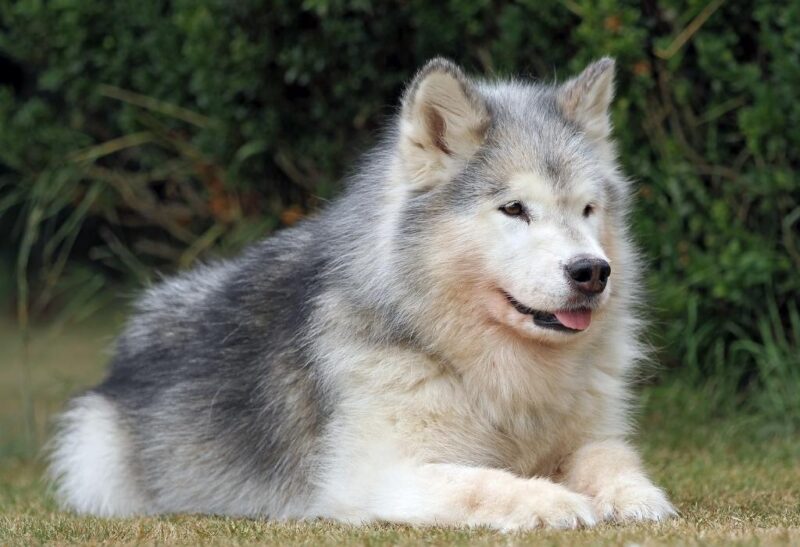Dogs or the Canis familiaris are direct descendants of the Canis Lupus or the wolves. With that being said, dogs were domesticated from wolves.
What dog is closest to a wolf? There are several dog breeds closest to wolves, including the Siberian Husky, American Alsatian, King Shepherd, Samoyed, and many more. These dogs and wolves share the same DNA at approximately 98.8%.
By reading this guide further, you will encounter more dog breeds closely related to wolves. On top of that, you will also know more about their respective characteristics, origin, and many more!
Table of Contents
20 Dog Breeds Closest to a Wolf
American Alsatian

The American Alsatian is a large-breed dog developed in California in the 1980s by Lois Denny, now Lois Swarchz, back in 1987. This dog breed was developed to look like the extinct Dire Wolf.
Dogs under this breed have medium coats and can vary in color, ranging from gold, silver, cream, or black sable. The silver sable American Alsatian is among the most attractive, while the black and white sable is incredibly rare.
- Appearance: The American Alsatian has a similar look to the dire wolf. The eyes of these dogs are almond-shaped, and their color varies from light brown to yellow with a wolfish gaze. On top of that, they have broad hips and heads with dark muzzles.
- Color: Gold, black, silver, cream sables
- Lifespan: 9 to 13 years
- Size: 25 to 28 inches (adult males) and 24 to 27 inches (adult females)
- Weight: 79 to 120 pounds or 36 to 55 kg (adult males) 75 to 100 pounds or 34 to 45 kg (adult females)
- Diet: Eggs, meat, gravy, and formulated Kibble
- Place Of Origin: California
- Characteristics: They’re cautious of outsiders but are never fearful or aggressive towards them. They’re calm, intelligent, loyal, and can learn training orders quickly.
Siberian Husky
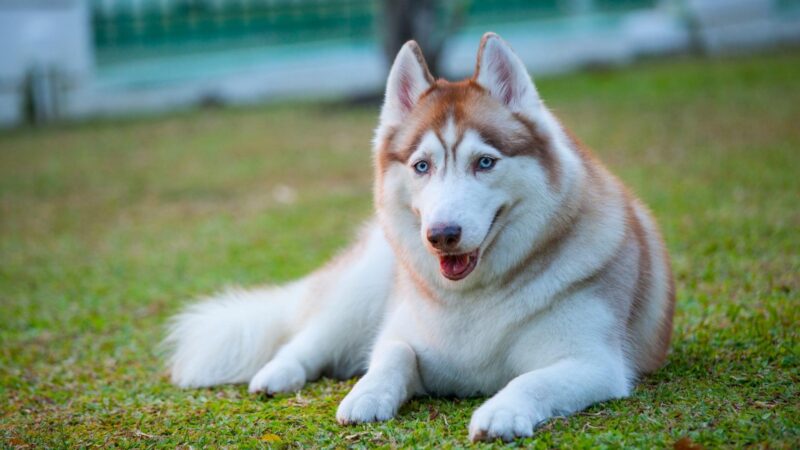
Siberian huskies are another dog breed that is closest to wolves. They originated from Siberia and are famously known as sledding dogs.
These dogs are intelligent and friendly but can also be stubborn and independent. They flourish in company with humans but require firm yet gentle training when they’re still puppies.
During warm weather, Siberian huskies can become excessive diggers since they love to make cool areas to like.
- Appearance: Siberian huskies have thick, plush furs with tons of undercoats. A small ruffle can also be seen around their neck, but no long ruffles on their tails or legs and have white markings, notably on their legs and chest.
- Color: White, black, black and tan, black and white, gray, silver-gray, etc.
- Lifespan: 12 years to 15 years
- Size: 20 kg to 27 kg (adult males), 16 kg to 23 kg (adult females)
- Weight: 20 kg to 27 kg (adult males), 16 kg to 23 kg (adult females)
- Diet: Commercial dog food, raw red meat, chicken, fish, beef, lamb, fruits (no prunes, raisins, or grapes), and vegetables.
- Place Of Origin: Siberia
- Characteristics: Siberian huskies are a highly intelligent dog breed with a gentle, friendly, and outgoing temperament. They’re independent and affectionate to almost everyone but don’t frequently pester their owners for attention.
Samoyed
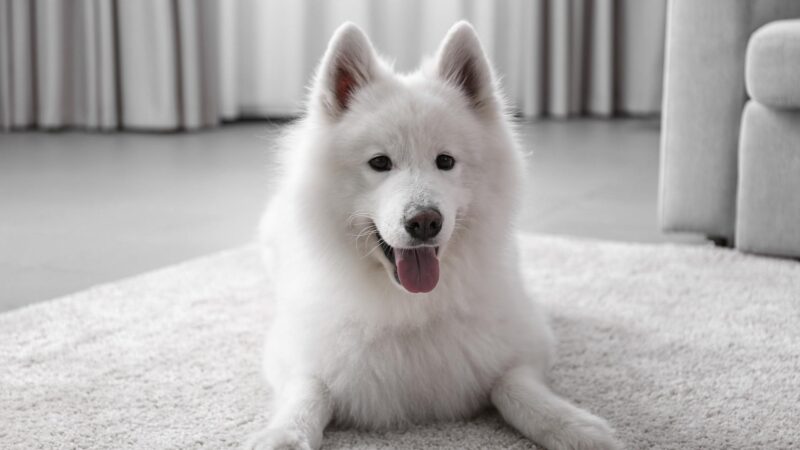
Samoyed dogs are another breed of dogs that are closest to wolves. These dogs’ existence dates back to 1000 BCE and hasn’t changed much in their temperament or appearance ever since then.
They got their name from the Samoyed people—a nomadic tribe living in the tundra near the Arctic Circle of Siberia and Northern Russia. These dogs are medium in size with thick double-layer coats that are white.
Since Samoyed dogs are a working breed, they can be strong-willed but remain gentle, friendly, and affectionate family dogs.
- Appearance: Samoyed dogs are medium in size and are squarely built, with a silky plumed tail coiled over their back and hanging to one side. On top of that, their heads are broad, and their ears are pricked.
- Color: White, cream, white & biscuit
- Lifespan: 12 years to 14 years
- Size: 19 inches to 23 1/2 inches
- Weight: 50 pounds to 65 pounds (23 kg to 29 kg)
- Diet: Fresh, lean raw meat, eggs, fresh vegetables, or fruits
- Place Of Origin: Russia and Siberia
- Characteristics: Samoyeds are social dogs and often adored being in family surroundings. They’re typically fantastic with children and are loyal to the entire family—but they can also sometimes show favoritism to one family member.
Shiloh Shepherd
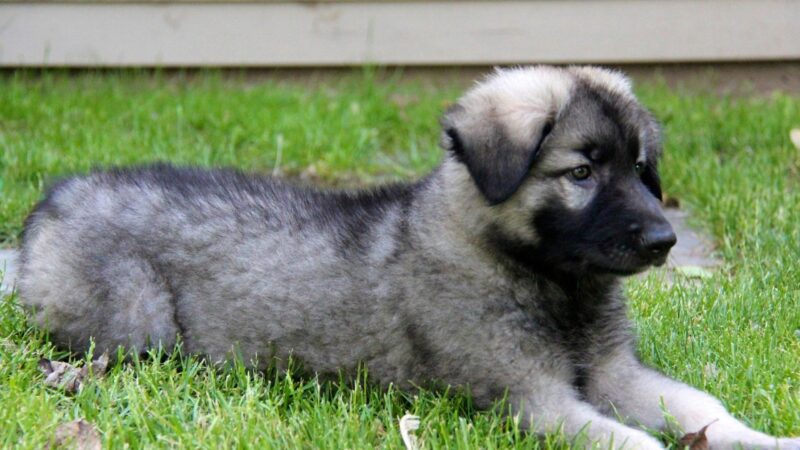
The Shiloh Shepherd dog breed was formed in New York in the 1970s by Tina Barber—a German Shepherd enthusiast and was recognized officially as a breed in the 1990s.
This dog breed is a mix of Alaskan Malamute and German Shepherd in their genotype. Tina Barber—the developer, wanted to make a dog identical to the German Shepherd but larger and more gentle.
These dogs particularly need a ton of exercise and enough space to stretch their legs. Getting daily stimulation and exercise makes these dogs happy and active.
- Appearance: This dog breed comes in various colors, ranging from brown, black, red, pied, and red. Typically, their coat is a mix of two colors, like black and tan. They have large bodies with a pointy muzzle and defined cheekbones.
- Color: Black and tan, golden, silver, cream, dark brown, red
- Lifespan: 9 years to 14 years
- Size: 71 cm to 76 cm ( adult males), 66 cm to 76 cm (adult females)
- Weight: 54 kg to 65 kg (adult males), 45 kg to 54 kg (adult females)
- Diet: Raw meat, fresh vegetables, and fruits, dry commercial kibbles
- Place Of Origin: United States
- Characteristics: The Shiloh shepherds are highly trainable and intelligent dogs, allowing them to learn quickly any tricks or tasks. They’re also very loving and less aggressive types of dogs.
King Shepherd
King Shepherds are a giant dog breed that originated in the United States, closely related to wolves. They have a long snout, pointy ears, and thick furs on their athletic body.
These giant hybrid dogs are the result of the cross-breeding of Shiloh Shepherds and German Shepherds. Their massive size allows them to stand out from their close relatives—the German and Shiloh Shepherds.
Despite their massive stature and relatively intimidating appearance, King Shepherds are typically very friendly, sweet, calm, protective, and loyal to their owners. They’re also not aggressive, making them an ideal pet.
- Appearance: King Shepherds have medium-length thick coats, giving them a regal impression. The color of their coats varies from red, brown, black, sable, or fawn. Nonetheless, their coat’s colors are usually a mix of two colors.
- Color: Brown, black, sable, red, and fawn
- Lifespan: 10 years to 11 years
- Size: 69 cm to 81 cm (adult males), 64 cm to 71 cm (adult females)
- Weight: 41 kg to 68 kg (adult males), 34 kg to 50 kg (adult females)
- Diet: 3 to 4 cups of dry dog food every day, broth or water, canned food
- Place Of Origin: United States
- Characteristics: King Shepherds are usually very calm and adaptable dogs. They’re also typically very gentle, loving, and intelligent, making them ideal pets for families with kids.
Finnish Lapphund

The Finnish Lapphund dogs are a spitz-type breed with an easy-going personality. They’re traditionally used for herding reindeer and are one of the most famous breeds of dogs in their country—Finland.
They have heavy coats, making them appear larger than their exact size (medium-size). On top of that, their coats are either straight or wavy with soft, and their sweet and soft nature will surely win your heart!
- Appearance: The Finnish Lapphund is a medium-sized, strongly-built dog. It has a profuse coat with pricked, highly mobile ears, distinctive markings, and an elegant nose.
- Color: Sable, white, black, wolf-sable, brown, and red
- Lifespan: 12 years to 14 years
- Size: 46 cm to 52 cm (adult males), 41 cm to 47 cm (adult females)
- Weight: 15 kg to 24 kg (adult males and females)
- Diet: Grain-free kibble, lentils, legumes, peas, canned foods, and other foods with healthy
- Place Of Origin: Finland
- Characteristics: The Finnish Lapphund dogs are a very active and clever breed. They also take training very well due to their intellect. Dogs under this breed are also alert and friendly but often bark at strangers, making them good watchdogs.
Caucasian Shepherd
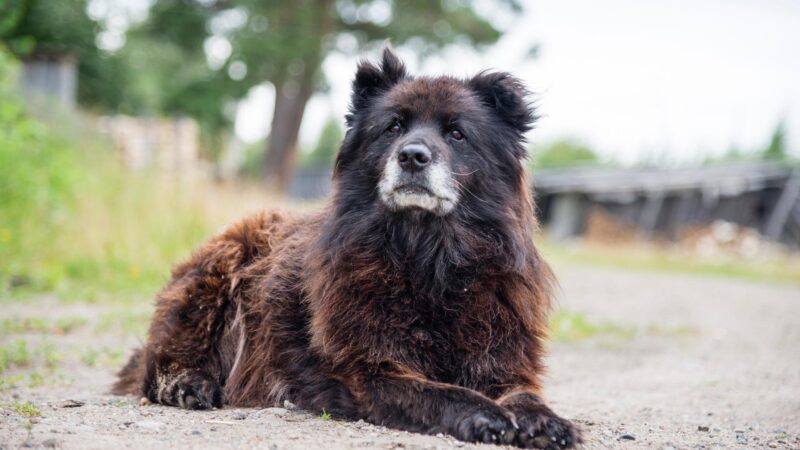
Caucasian Shepherds are another dog breed that is closely related to wolves. These dogs are strong, loyal, courageous, and fierce protectors of the home.
They are massive and highly territorial. With that being said, they won’t back down from any fight, even against wolves. However, dogs from this breed are usually stubborn and independent, making them challenging to train.
- Appearance: The Caucasian Shepherd dogs have bridle coats or two large patches on their furs. They come in various colors, such as fawn, gray, red, cream, solid white, or tan. They also often have white markings on their bodies and a dark mask-like around their faces.
- Color: Solid white, fawn, gray, red, tan, and cream
- Lifespan: 10 years to 12 years
- Size: 69 cm to 76.2 cm (adult males), 64 cm to 71 cm (adult females)
- Weight: 50 kg to 100 kg (adult males and females)
- Diet: High-quality dry food
- Place Of Origin: Azerbaijan, Circassia, Russia, Georgia, Turkey, Soviet Union, Armenia
- Characteristics: Caucasian Shepherd dogs are relatively loyal, and loving towards other family pets and even children. However, it’s very crucial to start their socialization exercise during their early years.
Seppala Siberian Sleddog
The Seppala Siberian Sleddog has a rough physical facade of wolves. This is because they came from the same ancestry.
However, the Seppalas are more friendly and docile than wild wolves. Although they have a tough wolf-like appearance, they choose to show their gentle expression.
What’s more remarkable about these dogs is that they were deemed the hero dogs and gained international fame, delivering medical supplies across the frigid Arctic regions.
- Appearance: Seppala Siberian Sleddogs are average-built-sized dogs, averaging 18 kg to 23 kg in weight and 56 cm to 58 cm in height. Their colors and markings vary, such as white & buff, and brownish-gray. On top of that, their eyes can be blue, brown, or a mix of two colors.
- Color: Sable, white & buff, black, gray, white, and brownish-gray
- Lifespan: 12 years to 15 years
- Size: 53 cm to 63 cm (adult males), 48 cm to 57 cm (adult females)
- Weight: 18 kg to 27 kg (adult males), 14 kg to 24 kg (adult females)
- Diet: Fruits, vegetables, canned food, broth, or water, cooked eggs, and cottage cheese
- Place Of Origin: Canada
- Characteristics: Seppala dog breed is diligent, intelligent, and highly trainable. With correct exercises, they can grow their muscular bodies. These dogs also understand their respective responsibilities, given their hardworking nature as Arctic dogs.
Shikoku
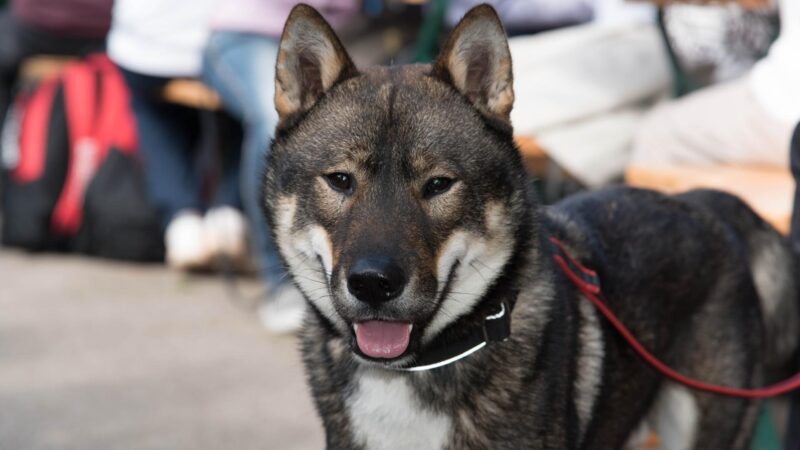
The Shikoku is a dog breed that originated way back in ancient Japan. These dogs were first bred to be hunting dogs in the mountainous communities of Kochi Prefecture.
The Shikoku is a dog of considerable endurance, sharp sense with a trusting emotion. They’re also very energetic, highly alert, and active hunters but docile towards their masters.
- Appearance: These dogs are medium in size with well-balanced and developed clean-cut muscles. They have compact bodies with straight outer coats and thick and soft undercoats.
- Color: A mix of black and tan and red and black
- Lifespan: 10 years to 12 years
- Size: 49 cm to 55 cm (adult males), 43 to 49 cm (adult females)
- Weight: 14 kg to 25 kg
- Diet: High-quality dog food
- Place Of Origin: Japan
- Characteristics: Shikokus are energetic, loyal, agile, and cautious dogs with excellent hunting abilities. They’re also quick learners, but their independent nature makes them hard to train since they sometimes choose not to listen to commands.
Kugsha
The Kushaga wolf-dog was first called the American Husky. This dog breed was developed in Pennsylvania by three wolf-breeders—Kulwind, Gordon Smith, and Habben.
There’s not much information about this breed except about their place of origin and their demanding and primitive nature. It’s best to note that these dogs are high wolf hybrids, so it’s best to expect that they can have unpredictable temperaments.
- Appearance: Kushgas have an undeniable resemblance to wolves with their distinct head shape, size, and color of their coats. They also have long legs, a narrow chest, furred small ears, and tails with a black tip.
- Color: Gray, white, fawn, and brown
- Lifespan: 14 years to 16 years
- Size: 50 cm to 69 cm long (adult)
- Weight: Over 100 pounds
- Diet: High-quality dry dog food, raw meat, eggs, tuna, and salmon
- Place Of Origin: Pennsylvania
- Characteristics: Since Kushga descended directly from wolves, they can have the same wild nature as wolves. They can also be aggressive and moody.
So, if you wish to pet this dog breed, you must train it and have it undergo proper socialization during its early years. Once trained correctly, they can be loving, bonded, and hardworking dog types that you will love to care for.
Canadian Eskimo Dog
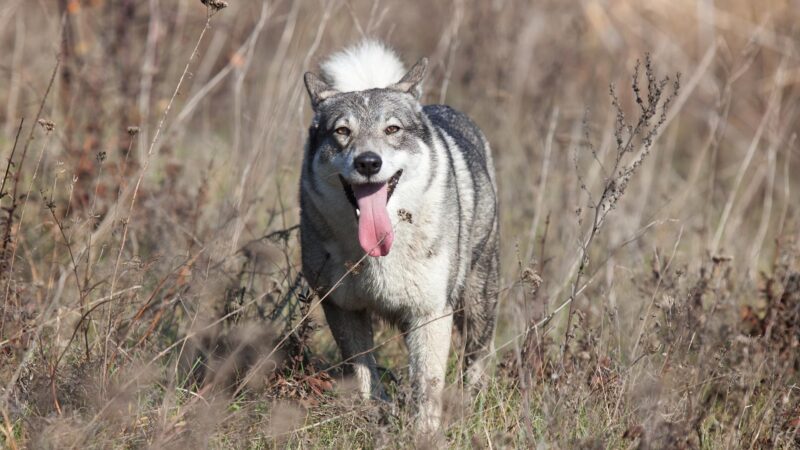
The Canadian Eskimo dogs’ existence dates back 4,000 years ago to the Eskimo people. These dogs were initially bred to help the Inuits hunt and pull sleds.
While they are friendly to most people, these dogs can be aggressive and challenging to handle. It also does not interact well with other dogs due to its pack conduct.
- Appearance: These dogs are built like enormous malamutes or huskies. Their heads are shaped like wedges, with short, pricked ears. In addition, their eyes are almond-shaped with dark brown to amber color, and their tails are curled over their backs like huskies. In general, this dog breed typically matures during its third year but reaches its full size when they are one year old.
- Color: White, gray, gray and white, brown and white, black and white, and red and white
- Lifespan: 10 years to 15 years
- Size: 58 cm to 70 cm in height (adult males), 50 cm to 60 cm in height (adult females)
- Weight: 30 kg to 40 kg (adult males), 18 kg to 30 kg (adult females)
- Diet: High protein foods, like meat, fish, seal, and deer
- Place Of Origin: Canada
- Characteristics: These dogs are gentle, affectionate, and loyal to their owners. They are also hardworking dogs that are pack-oriented, so they may not go along well with other pets at first.
Swedish Vallhund

The Swedish Vallhund dog breed is an ancient, national dog originating from the county of Sweden. They are among the most famous and oldest dog breeds from Sweden, dating over 1,000 years ago.
Although the Swedish Vallhunds are small dogs, they have proven themselves as excellent dogs for guarding houses and herding.
- Appearance: The Swedish Vallhund has an average height of around 32 cm for males and 30 cm for females. They have long bodies with wedge-shaped heads, deep brown oval eyes, and pointy ears.
- Color: Gray, mahogany, blue, grayish-brown and grayish-yellow
- Lifespan: 12 years to 15 years
- Size: 32 cm to 34 cm in height (adult males), 30 cm to 32 cm in height (adult females)
- Weight: 9 kg to 14 kg (adult males), 9 kg to 14 kg (adult females)
- Diet: Healthy fats, proteins, vegetables, and ground bones
- Place Of Origin: Sweden
- Characteristics: The Swedish Vallhund is friendly, intelligent, fearless, alert, and watchful. They’re also very loving and playful towards their owners. However, these dogs tend to have high-pitched barks, which isn’t ideal if you have strict neighbors.
German Shepherd
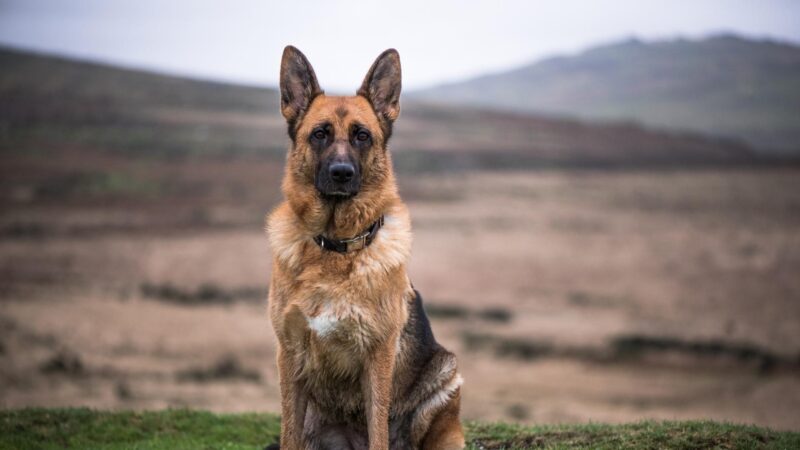
As their name suggests, these dogs originate from Germany, dating back to the late 1800s. During the 1950s, German dog breeders tried to normalize dog breeds to keep the best attributes that helped them with their herding job.
These dogs usually are aloof but not typically aggressive. In fact, they are approachable and easy-going when around their family members. However, they can be powerful and extra protective, making them ideal as watchdogs.
- Appearance: German Shepherds have a square head, a long muzzle, pointy ears, straight legs, long coats, and bushy tails.
- Color: Black, sable, gray, blue, black and tan, red and black, brown, black and silver
- Lifespan: 9 years to 13 years
- Size: 60 cm to 65 cm in height (adult males), 55 cm to 60 cm in height (adult females)
- Weight: 30 kg to 40 kg (adult males), 22 kg to 32 kg (adult females)
- Diet: Beef, lamb, pork, fish, chicken, eggs, vegetables, grains, and legumes
- Place Of Origin: Germany
- Characteristics: German Shepherds are the very loyal, protective, watchful, obedient, and curious dog breed you’ll ever come across. At first, they will be aloof and reserved, but once you gain their trust, they will be the most loyal and protective dogs you will ever encounter.
Tamaskan

Tamaskans are husky-type dogs that originated from Finland and were imported from the United States in the 1980s. They were a mix of Alaskan Malamute, German Shepherd, and Siberian Husky.
They are very intelligent and versatile in their working abilities, but this breed isn’t for everyone. These dogs are most suitable for experienced dog owners who have enough time to nourish them with exercises and mental stimulation.
- Appearance: Tamaskans are enormous, athletic working dogs with wolf-like appearance, thick coats, and straight, bushy tails. Their colors vary from black-gray, red-gray, and wolf-gray. In addition, their eye colors are amber, yellow, and brown in color.
- Color: Black-gray, red-gray and wolf-gray
- Lifespan: 14 years to 15 years
- Size: 63 cm to 71 cm in height (adult males), 61 cm to 66 cm (adult females)
- Weight: 30 kg to 45 kg (adult males), 23 kg to 38 kg (adult females)
- Diet: Low carbohydrate and high protein diets, such as frozen fish, raw seal, and reindeer meat
- Place Of Origin: Finland
- Characteristics: The Tamaskans are gentle in nature and are often friendly with children and other dogs. They are also intelligent, with excellent agility, and obedient to their owners if trained well.
Shiba Inu
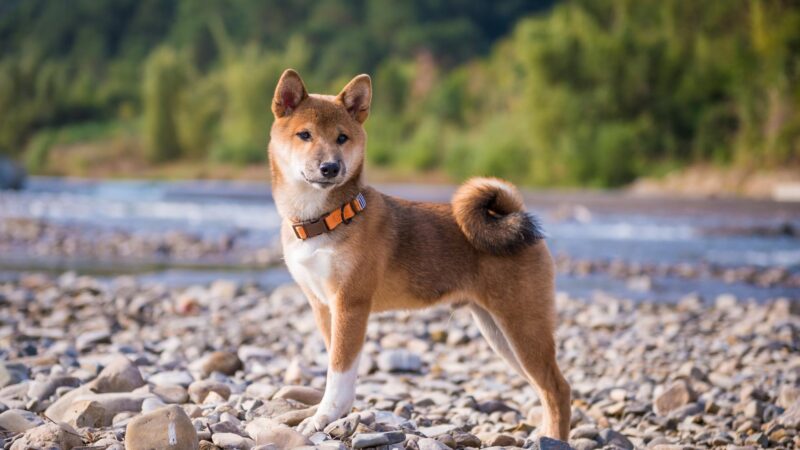
The Shiba Inu dogs are another dog breed closely related to wolves. They originated from Japan, along with the Shikoku, Hokkaido, Akita, and Kishu, and were used mainly as hunting dogs.
Currently, they serve specifically as companion dogs in the United States and Japan but note that they are not the easiest dog breed to train.
- Appearance: Shiba Inu has a fox-like appearance, with a classic orange-red color. They also come in cream, sesame, black and tan. Furthermore, they have thick, double-coated coats, just like the Siberian Huskies.
- Color: Sesame, red, black & tan, red sesame, and cream
- Lifespan: 12 years to 15 years
- Size: 35 cm to 43 cm in height (adult males), 33 cm to 41 cm (adult females)
- Weight: 8 kg to 11 kg (adult males), 6.8 kg to 9 kg (adult females)
- Diet: Wildfowl, small game, fish, vegetables, and rice
- Place Of Origin: Japan
- Characteristics: The Shiba Inus are aggressive, alert, intelligent, strong-willed, and spirited dogs. However, due to their independent nature, training them can be challenging.
Northern Inuit Dog/Utonagan
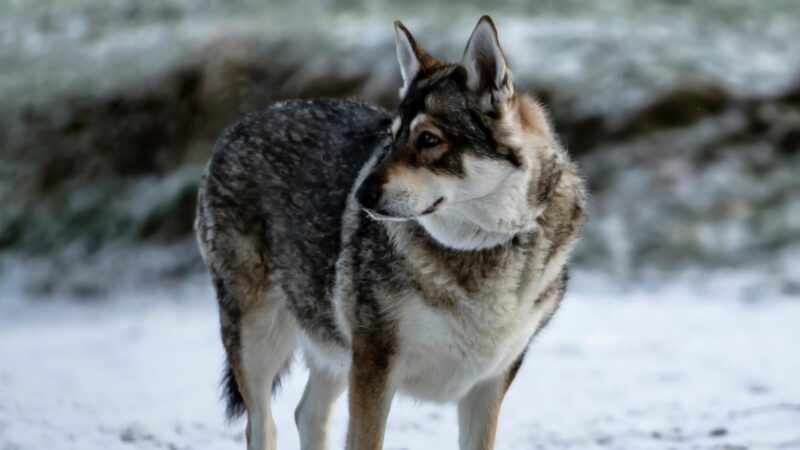
The Northern Inuit is a hybrid dog breed with a much-disputed background. However, what’s sure is that Malamute, Husky, and German Shepherd are parts of their mixed ancestry.
These dogs are friendly, calm, intelligent, and excellent as family pets.
- Appearance: The Utonagan dogs are captivating, huge dogs with wolf-like qualities. They have erect ears, long muzzles, thick double coats, and curled tails.
- Color: Sable, white, gray, black, apricot, and a mix of these colors
- Lifespan: 12 years to 14 years
- Size: 58 cm to 81 cm in height (adult males), 58 cm to 71 cm (adult females)
- Weight: 24 kg to 38 kg (adult)
- Diet: High protein kibbles and raw diets of meat, eggs, bones, etc.
- Place Of Origin: United Kingdom
- Characteristics: Northern Inuit Dogs are a loyal and affectionate dog breed. They may look like wolf dogs but aren’t. They’re a mix of Siberian Huskies, Alaskan Malamutes, and German Shepherds—the reason why they still have a temperament of a domesticated dog while having a wolf appearance.
Saarloos Wolfdog
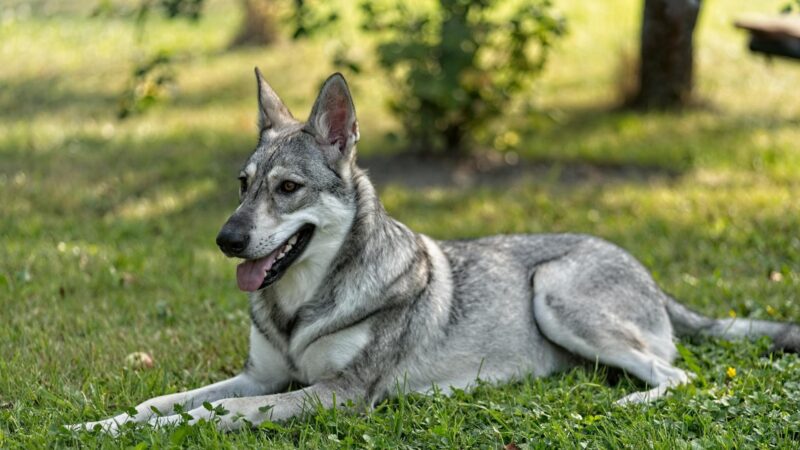
The Saarloos Wolfdog is an athletic-built wolf-dog breed that originated in the Netherlands. This has been made possible by the crossing of the Siberian gray wolf and German Shepherd.
Initially, the Saarloos wolfdog was named the European Wolfdog, but it was renamed Saarloos Wolfdog by the Dutch Kennel Club in honor of its creator, Leendert Saarloos.
- Appearance: Saarloos wolfdogs have a muscular physique with agile and swift movements. They have long, erect ears and a wedge-shaped head with yellow or brown almond-shaped eyes.
- Color: White, red and wolf-gray
- Lifespan: 10 years to 12 years
- Size: 65 cm to 75 cm in height (adult males), 65 cm to 75 cm (adult females)
- Weight: 36 kg to 45kg
- Diet: Raw meat, salmon, fish, turkey, egg, apple, and corn
- Place Of Origin: The Netherlands
- Characteristics: Saarloos Wolfdogs are highly brilliant and are a curious breed. If not stimulated physically and mentally, they can display violent behaviors. However, if properly trained and nurtured, they can become an excellent addition to your family.
Czechoslovakian Wolfdog
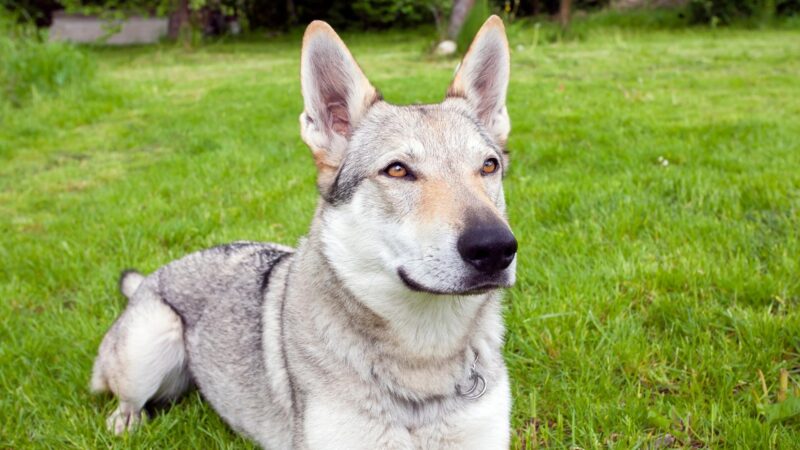
The Czechoslovakian Wolfdogs are a result of an experiment in 1955 in Czechoslovakia. These dogs are large and are around 60 to 65 cm tall, weighing approximately 20 to 26 kilograms with 13 to 16 years of lifespan.
- Appearance: Czechoslovakian Wolfdogs have a wolf-like appearance with a strong jaw, erect ears, and amber eyes. They are also very agile, helping them with their endurance and stamina levels.
- Color: Gray, yellow-gray, silver-gray
- Lifespan: 13 years to 16 years
- Size: 65 cm (adult males), 60 cm (adult females)
- Weight: 26 kg (adult males), 20 kg (adult females)
- Diet: Raw and kibble diets
- Place Of Origin: Czechoslovakia
- Characteristics: The Czechoslovakian Wolfdogs can be aggressive if humans will not display proper authority. They don’t do well with other pets but can be good with children. These dogs are also highly suspicious and vigilant with strangers.
Alaskan Malamute

The Alaskan Malamutes are one of the oldest sled dog breeds in the Arctic, originally used to carry heavy loads of food supplies. They were also used to ward off polar bears and hunt for seals.
- Appearance: Alaskan Malamute has a wolf-like look with imposing characteristics, with its tail curled over its back, a very dense coat, wedge-shaped head, and erect ears.
- Color: Seal & white, black & white, red &white, white & chocolate, sable & white, gray & white
- Lifespan: 20 years to 12 years
- Size: 61 cm to 66 cm (adult males), 56 cm to 61 cm (adult females)
- Weight: 36 kg to 43 kg (adult males), 32 to 38 (adult females)
- Diet: Healthy fats, proteins, vegetables, and ground bones
- Place Of Origin: Alaska
- Characteristics: These dogs have sturdy bodies and keep incredible strength, endurance, energy, intelligence, and independence.
Basenji
The Basenji dogs are deemed ‘Barkless Dog’ in Africa. They have compact bodies and sweet faces but don’t let that fool you, as they are ferocious hunters with high intelligence.
They are charming and unique, but they are only best for owners who can fulfill their training needs.
- Appearance: Basenjis are small, agile dogs, recognizable by their shiny short coat, wrinkled forehead, tightly coiled tail, and expressive eyes.
- Color: Black, tan, red, tri-color, bridle, black & white
- Lifespan: 12 years to 16 years
- Size: 41 cm to 43 cm (adult males), 38 cm t0 41 cm (adult females)
- Weight: 11 kg (adult)
- Diet: Raw meat and vegetables
- Place Of Origin: The Democratic Republic of the Congo
- Characteristics: These dogs can be aloof at first but can become very affectionate with their own family. Basenjis are also intelligent and independent dogs, making them challenging to train.
What Is the Difference Between a Wolfdog and a Wolf-Like Dog?
Wolf-dog is a hybrid created by cross-breeding a pure domestic dog with a pure wolf, while wolf-like dogs are created to look like wolves but without the genes of pure wolves.
Wolf hybrids are created by breeding a wolf with any species of domestic dogs, like German shepherds, Akitas, Alaskan Malamutes, and huskies. Nonetheless, this mix of wild and tamed genes contributes to the rise of a complex mosaic of nature and intuition.
Frequently Asked Question
Can a Wolf Mate With a Dog?
Wolves can mate with dogs. However, the mix of wild and tame nature can create complex behaviors in the offspring.
Are Dogs and Wolf the Same Species?
For many years, dogs and wolves have been considered separate species—the Canis familiaris and Canis lupus. However, in recent years, scientists have deemed that dogs are a subspecies of wolves called Canis lupus familiaris.
Can a Wolf Be a Pet?
Keeping pure wolves as pets is illegal in America. However, if you want to own a dog with a wolf-like appearance or partly wolf, there are hybrid dogs available that you can choose from, such as those listed above.
Summary
If you are planning to get a dog breed that’s closely related to wolves, you choose from the breed of dogs that are listed above. Also, look into their characteristics to help you determine if they are the right breed for you.
List of Sources
Aguirre-Hernández, J., Wickström, K., Sargan, D. R. (2007). The Finnish lapphund retinal atrophy locus maps to the centromeric region of CFA9. BMC veterinary research.
German Shepards. (2015). Southern Illinois University Edwardsville.
Polly, P. D. Dire Wolf. Indiana University.
Togo. (2021). National Park Service – U.S. Department of the Interior.
